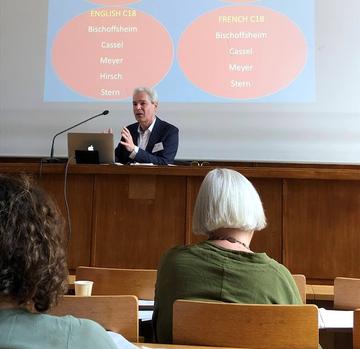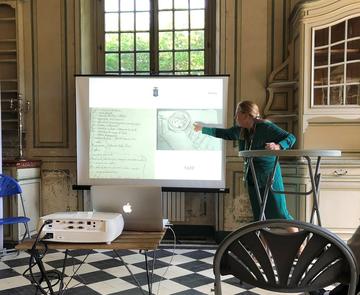Collectionneurs juifs et tendances du goût / Jewish Collectors and Patterns of Taste (ca 1850-1930) (June,2022)

In late June 2022, we were delighted to be able to gather with colleagues from across Europe, Israel and America for a three-day workshop in Paris. It was an opportunity to engage with some new research on the topic of Jewish collectors and their contribution to wider trends in taste between 1850 and 1930, and to hear from heritage professionals who have been restoring Jewish narratives to their interpretation of historic buildings and collections.
Organised by our colleagues responsible for the ‘Collecting’ strand of the Jewish Country Houses research project, Silvia Davoli and Tom Stammers, in association with Professor Cyril Grange (Centre Roland Mousnier), who kindly hosted us at the Sorbonne, the bi-lingual workshop also presented an important opportunity to work closely with two of our formal partners, the National Trust and the Centre des Monuments Nationaux.
The first session of Monday 27 June was introduced by Philippe Bélaval, President of the Centre des Monuments Nationaux, who welcomed delegates to Paris (in French and superb English) and expressed his organisation’s commitment to promoting research into the collections and historic houses associated with important Jewish families, like the Cahen d’Anvers and the Reinachs. He welcomed this sequel to our 2019 conference with the Centre des Monuments Nationaux at Kerylos, and applauded the development of the recently launched AEJP European Jewish heritage route, ‘Palaces, Villas and Country Houses’,.

John Hilary on German Jewish collectors (Photo E Pergam)
The first keynote was given by Professor Dominique Jarrassé (Université Bourdeaux-Montagne), whose paper introduced three of France’s most significant Jewish patrons of art, Isaac Strauss (1806 – 1888), Daniel Iffla“Osiris” (1825–1907), and René Weiner (1855–1939). Professor Jarrassé problematised the category of a ‘Jewish’ collector and ‘Jewish’ taste, warning against essentialism and toxic generalisations; he also reflected on the specifically French cultural model of integration in which Jewish collections were displayed in a national museum (in the case of the Strauss collection, the Musée de Cluny). Panel One, chaired by Jaclyn Granick (Cardiff University) was concerned with trends in Jewish collecting across various European cultural contexts, as we heard from Maddelena Alvi (Rijksmuseum, Amsterdam) on the German art market during the First World War. John Hilary (University of Nottingham) discussed many of the JCH-owning German Jewish collectors who established their collections in Edwardian Britain, while Mia Laufer of the Des Moines Art Center presented a paper remotely on Jewish patrons of French artist Gustave Moreau, and why his work came to be seen as appealing to their taste.
After lunch at the atmospheric Polidor restaurant, Veronique Gerard Powell (Sorbonne), Lizzie A. Pergam (Independent Scholar, Society for the History of Collecting) and Neta Peretz (Hebrew University of Jerusalem) discussed three significant 19th century Jewish collecting families in Britain and France (namely Lewis, Mendel and Pereire), in a session on ‘Jewish patronage of Contemporary Artists’, chaired by Lindsay Macnaughton (University of Buckingham). A small change to the programme meant Elana Shapira’s (University of Vienna / University of Applied Arts Vienna), paper on Viennese modernist art collectors will be circulated to delegates at the close of the workshop. The afternoon ended with Panel Three, chaired by Cyril Grange, exploring how Jewish collectors and patrons mobilised transnational networks to display and store their works of art. Emily Bilski (Library Fellow, The Van Leer Jerusalem Institute) shared new findings on the Berlin-based collectors Carl and Felicite Bernstein, Christel H. Force (Independent Scholar) discussed the efforts of Marianne de Goldschmidt-Rothschild to ‘roll canvases’ across increasingly hostile national borders, while Martine Sitt (Universität Kassel) highlighted the difficulty of working on Jewish art dealers, who like many in their trade, may have operated under pseudonyms. We also heard from colleagues Merel van Erp and Mara Lagerweill of the Rijksmuseum about their plans to recognise the Dutch Jewish art dealer Fritz Mannheimer in an upcoming display in Amsterdam.
We then relocated to the Musée d'Art et d'Histoire du Judaïsme (MAHJ) in the Marais, taking our seats in the lecture theatre located below an extraordinary 17th century hôtel particulièr. Here we were introduced to France’s largest bibliographic collection on the history of French Jews by the museum’s director, Paul Salmona. After his introduction, we were treated to our second keynote of the day, delivered by Caroline Weber (Barnard College, Columbia University), author of Proust's Duchess (Knopf, 2018). In her talk Professor Weber vividly reconstructed Proust’s cultural milieu and the influence exerted on his imagination by attendance at salons run by Jewish women. It was the ideal prelude to our guided tour the current exhibition, ‘Marcel Proust,du côté de la mère’, an exploration of the author’s varied and oblique references to his own Jewish heritage. We were also able to view some of the star pieces from the Strauss collection, mentioned by Professor Jarassé in his talk that morning.
Tuesday 28th June also began at the Sorbonne, with a keynote paper by architectural historian Frederic Bedoire (The Royal Academy of Fine Arts, Stockholm) on the Rothschild family’s European homes, and their influence on American collectors. Professor Bedoire is the author of the important monograph The Jewish Contribution to Modern Architecture 1830-1930 (Ktav,2004). After this keynote Dr Oliver Cox (University of Oxford) and Sylvie Legrand-Rossi (Conservatrice générale du Patrimoine, Musée Nissim de Camondo) jointly chaired a discussion of élite French Jewish families the Camondos, Reinachs, and Dorvilles, with bilingual papers presented by Nora Seni (Université Paris-8,), Hervé Duchêne (Université de Bourgogne) and Nathalie Neumann (University of Mainz),respectively. We were delighted that David Zivie, appointed by President Macron to oversee research into looted cultural property between 1933-45, was able to join us to reflect on recent restitution initiatives by the French government, and the moral importance of such work.
The afternoon was no less fruitful, with Panel Five, chaired by Sasha Goldstein-Sabbah (Groningen University), hosting a colloquium on Jewish collectors of various types of ‘Oriental’ artwork, at which we heard papers from Ayse Aldemir on Jewish dealers in the late Ottoman Empire (Sabanci University, SakipSabanci Museum, Istanbul), Yuka Kadoi on the market for Persian art (University of Vienna) Laura-Marijke Hecker on Chinese art in interwar Berlin (Independent Researcher) and Nick Pearce on the underrated female collector of Chinese porcelain Brenda Seligman (University of Glasgow). The closing session was chaired by Luisa Levi D’Ancona Modena(Hebrew University of Jerusalem) and examined the idea of collecting as an intellectual pursuit. Tobias Kämpf (FAU Erlangen-Nuremberg/ Germanic National Museum, Nuremberg) discussed Scandinavian Ernest Thiel’s ‘Nietzschean Gallery’, Stefano Cracolici (Durham University) drew from Bernard Berenson’s autobiographical writings to explore how his Jewish heritage shaped his conversion to Christian and Renaissance art, and finally Milena Woźniak-Koch (Centre for Historical Research of the Polish Academy of Sciences, Berlin) examined collector BronisławKrystall’s aesthetic ideals. The evening came to a celebratory close in the courtyard of the Musée Nissim de Camondo, where we could explore the exquisite collections and raise a glass courtesy to the kind welcome of Sylvie Legrand-Rossi and her colleagues.

Caterina Sonnino presents at the Chateau de Champs (photo E Pergam)
The final day of the workshop, focusing on museums and heritage sites with Jewish patrons, took place in the sunny dairy located in the gardens of the Château Champs sur Marne (CMN), former home of the Cahen d’Anvers family, and the subject of Alice Legé’s doctoral research, which she introduced over breakfast. Silvia Davoli chaired the first ‘Heritage Perspectives’ panel, which was opened by Sally-Anne Huxtable (Head Curator, National Trust) who outlined the Trust’s collaboration within the Jewish Country Houses project, and explored the enigmatic figure of Hannah Gubbay . George Roberts (National Trust) told us about Mottisfont Abbey’s doyenne Maud Russell, a champion of modern art who also sheltered her German Jewish family members. Olga Melasecchi (Director, Jewish Museum of Rome) and Gaia Fiorentino introduced the exceptional collections of the Jewish museum in Rome, and explored how some twentieth-century Italian Jewish collectors navigated the crisis of Fascism. Caterina de Renzis Sonnino (Founder, Castello Sonnino international education center) demonstrated how her own family’s thriving vineyard and learning programming seeks to renew the progressive Jewish heritage of the site.
Sally-Anne Huxtable (NT) chaired the final panel of the workshop, which looked at the recent turn toward Jewish house museums in Scandinavia. Patrik Steorn (Director, Gothenburg Museum of Art), presented on the Ernest Thiel Gallery, a Gesamkunstwerk celebrating Nordic art and ideals. The final papers, given by Charlotta Nordström (remotely) and Rasmus Kjaerboe of the Hirschsprung Collection, examined the impact of the ‘Fürstenberg Gallery’, a gift to the Danish people. They announced an exciting-sounding digital initiative to fully catalogue its holdings - a fitting way to end the workshop as it reflects the widening interest in provenance research among both audiences and heritage professionals alike.

The group tours the Chateau de Champs sur Marne (photo E Pergam)
After a light lunch in the grounds, curator Mathias Le Galic (CMN) invited us to tour the Chateau and gardens, which featured spot-lit displays of some of the most significant of the recently restored items of furniture and boiseries owned by the Cahen d’Anvers. A highlight for many was the former bathroom of Madame de Pompadour, one of the earliest to be fitted with modern conveniences. In the late nineteenth century it served as a dining room for the Cahen d’Anvers children, located adjacent to the formal entertaining spaces used to host diplomatic and social functions by their parents Louis and Louise.
On behalf of all the attendees I would like to extend my thanks to Briony Truscott, Research Projects Administrator (University of Oxford) for the extraordinary care and attention to detail which resulted in a wonderful conference, an opportunity to generate and share ideas, and build what will no doubt be highly-rewarding and fruitful partnerships across borders.
AHRC-supported CDA candidate (University of Durham / the National Gallery)
This workshop was supported by the National Trust, the Centre Roland Mousnier (Sorbonne Université), the Centre des Monuments Nationaux, and the Arts and Humanities Research Council [grant number AH/S006656/1].


